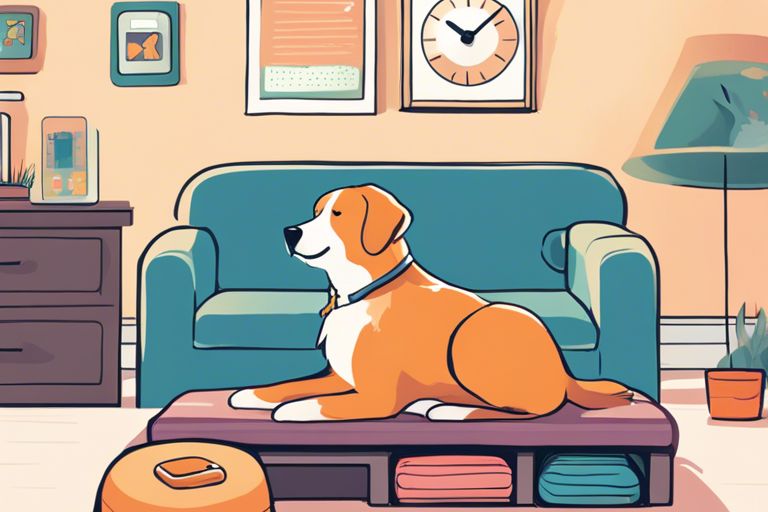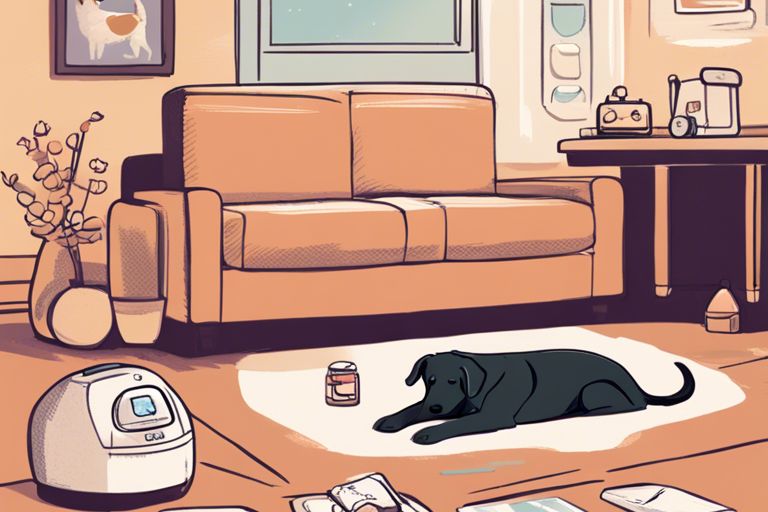Dealing with a dog suffering from separation anxiety can be a challenging experience, but it’s important to approach the situation with patience and understanding. If you notice your dog showing signs of distress when you leave, such as barking, whining, or destructive behavior, it’s crucial to address the issue promptly to prevent further stress and potential harm. Separation anxiety can negatively impact your dog’s well-being and may even lead to dangerous behaviors, so it’s essential to take steps to help your furry friend feel more secure and comfortable when alone. In this blog post, we will provide you with practical tips and strategies to address and manage separation anxiety in your beloved pet, so you can both experience peace of mind.
Key Takeaways:
- Recognize the signs of separation anxiety: Look for symptoms such as excessive barking or whining, destructive behavior, and pacing when you are preparing to leave or have already left the home.
- Gradually desensitize your dog to being alone: Start by leaving for short periods of time and gradually increase the duration to help your dog become more comfortable with being alone.
- Seek professional help if necessary: If your dog’s separation anxiety is severe, consider consulting a professional trainer or behaviorist to develop a tailored treatment plan for your pet.
Recognizing the Symptoms
The first step in addressing your dog’s separation anxiety is recognizing the symptoms. Separation anxiety is a condition in which a dog experiences distress and anxiety when left alone. This can manifest in a variety of behaviors, and it’s important to be able to identify them so you can take the appropriate steps to help your dog.
Common Signs of Separation Anxiety
Common signs of separation anxiety in dogs include excessive barking or howling when left alone, destructive behavior such as chewing on furniture or digging at doors, and having accidents in the house even though they are normally house trained. Some dogs may also exhibit pacing, panting, or restlessness when their owner is preparing to leave, and may become overly excited or frantic when the owner returns.
Differentiating from Other Behavioral Issues
It’s important to differentiate separation anxiety from other behavioral issues, as the treatment approach may differ. While symptoms such as destructive behavior or accidents in the house can also be signs of a lack of training or boredom, the key difference is the emotional distress that comes with separation anxiety. If your dog only exhibits these behaviors when left alone and shows signs of extreme distress, it’s likely that they are suffering from separation anxiety.
Prevention Strategies
Some dogs are predisposed to separation anxiety, but there are strategies you can implement to prevent this behavior from developing. By proactively addressing and managing your dog’s alone time, you can help them feel more comfortable and secure when you’re not around.
Preparing Your Dog for Alone Time
When you first bring your dog home, start by introducing short periods of alone time. Gradually increase the duration as they become more comfortable being by themselves. Use positive reinforcement, such as treats and praise, to create a positive association with alone time. You can also introduce them to a comfortable and safe space, such as a crate or a designated area in the house, where they can retreat when you’re not around.
Establishing a Routine
Establishing a consistent routine can help your dog feel more secure and less anxious when you’re not around. Consistent feeding, walking, and playtime schedules can provide predictability and structure, which can help alleviate anxiety. Incorporating exercise and mental stimulation into your dog’s daily routine can also help them release pent-up energy and feel more at ease when left alone.
Treatment Options
Unlike some medical conditions, separation anxiety in dogs can be managed and even improved with the right treatment. There are several options available to address your dog’s separation anxiety, including behavioral training techniques and professional help and therapy. It’s important to work with a veterinarian or a professional dog trainer to find the best approach for your specific situation. Here are some treatment options to consider:
Behavioral Training Techniques
When it comes to addressing separation anxiety in dogs, behavioral training techniques can be highly effective. By using positive reinforcement and desensitization, you can help your dog learn to feel more comfortable being alone. One popular technique is to practice leaving and returning in short increments, gradually increasing the time you are away. Additionally, providing engaging toys or activities for your dog to focus on while you are gone can help keep them calm and distracted. It’s important to be patient and consistent with these training techniques, as they can take time to show results.
Professional Help and Therapy
If your dog’s separation anxiety is severe or doesn’t respond to behavioral training techniques, seeking professional help and therapy may be necessary. A veterinarian or a certified animal behaviorist can provide guidance and recommend specific interventions, such as medication or specialized behavior modification programs. Medications can be used to help manage the symptoms of separation anxiety, but they should always be used in conjunction with behavioral training techniques. Professional help and therapy can provide the support and expertise needed to address your dog’s separation anxiety in a comprehensive way.
Managing Your Own Stress
Your own stress and anxiety can have a significant impact on your dog’s separation anxiety. Learning to manage your stress levels can not only benefit you, but also have a positive effect on your dog’s behavior.
The Impact of Owner Anxiety on Dogs
It’s important to recognize that your own anxiety can be transmitted to your dog. Dogs are highly sensitive to their owner’s emotions, and if you are feeling stressed or anxious, your dog is likely to pick up on those feelings. This can exacerbate their separation anxiety and make it more difficult for them to cope when you are not around.
Tips for Remaining Calm and Collected
There are several strategies you can use to help manage your own stress and remain calm and collected when dealing with your dog’s separation anxiety. Meditation and deep breathing exercises can be incredibly effective in reducing stress levels. Making time for regular exercise can also help to reduce anxiety and improve your overall mental wellbeing. Additionally, seeking support from friends, family, or a professional therapist can provide you with the tools and guidance you need to manage your stress effectively.
- Meditate or practice deep breathing exercises daily
- Engage in regular physical exercise
- Seek support from friends, family, or a professional therapist
Any changes you make to manage your own stress will ultimately benefit your dog as well, by creating a more stable and peaceful environment for them to thrive in.

Advanced Interventions
To address severe separation anxiety in your dog, advanced interventions may be necessary. These interventions can include medications and alternative therapies. It’s important to consult with a veterinarian or a certified dog behaviorist before starting any advanced interventions.
-
Medications and Their Use
Medications can be used to help manage severe separation anxiety in dogs. Your veterinarian may prescribe anti-anxiety medications such as tricyclic antidepressants or selective serotonin reuptake inhibitors (SSRIs) to help your dog cope with the stress of being alone. It’s crucial to follow your vet’s instructions carefully and monitor your dog for any side effects.
-
Alternative Therapies
In addition to medications, there are alternative therapies that can be used to help alleviate separation anxiety in dogs. These may include canine calming pheromones, acupuncture, or massage therapy. While these alternative therapies may not work for every dog, they can provide some relief for certain individuals. Always consult with a professional before trying these therapies.
What do I do if my dog has separation anxiety?
With these considerations in mind, it’s important to remember that addressing your dog’s separation anxiety will take time, patience, and consistency. It’s essential to gradually desensitize your dog to being alone by practicing short departures and gradually increasing the time spent away. Providing your dog with plenty of physical and mental stimulation, creating a safe and comfortable environment, and seeking professional help if needed are also important steps in managing their anxiety. Remember that every dog is unique, so it may take some trial and error to find the best approach for your furry friend. By taking the time to address your dog’s separation anxiety, you can help improve their overall well-being and quality of life.














